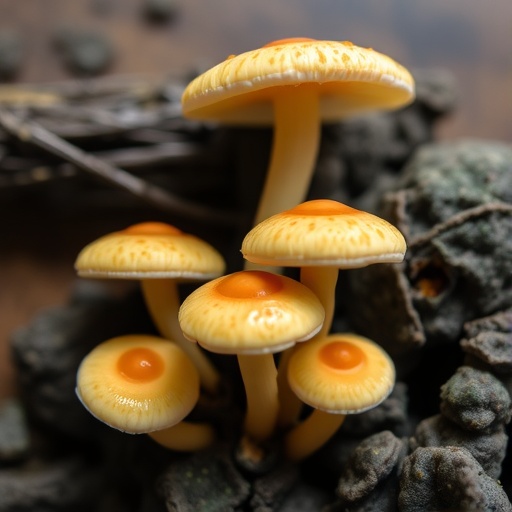In a groundbreaking development that could revolutionize the packaging and textile industries, researchers have unveiled a method to create waterproof coatings using edible fungi. This innovative approach promises a sustainable alternative to the pervasive problem of single-use plastics, which currently dominate as coatings for paper cups and plastic wraps. The team, led by Caitlin Howell at the University of Maine, demonstrated that a naturally grown fungal film could render everyday materials like paper, denim, and polyester felt resistant to water, oil, and grease. This study, published in ACS’s Langmuir, showcases the synergy between biological materials and nanotechnology to develop eco-friendly barrier coatings.
Central to this research is the fungus known as Trametes versicolor, commonly referred to as the “turkey tail.” Unlike the more conspicuous mushroom cap that we see above the ground, fungi like T. versicolor possess a vast underground network called mycelium, composed of fine, thread-like structures known as hyphae. These mycelial networks already possess inherent water-repelling properties. By harnessing these characteristics, the researchers aimed to cultivate a food-safe, sustainable coating that adheres to and protects various substrates effectively.
The approach involved blending mycelia from T. versicolor with cellulose nanofibrils (CNFs) — ultrafine fibers derived from wood pulp known for their strength and barrier properties. CNFs are increasingly utilized in material science due to their biodegradability and capacity to form dense networks impermeable to gases and liquids. The process began by immersing materials such as denim fabric, polyester felt, birch veneer, and paper in a nutrient solution containing the fungal spores and CNFs. Over several days, the fungal mycelium grew a sustained layer on these substrates.
What makes this fungal coating remarkable is its minimal thickness, comparable to a layer of paint, which forms after just a few days of fungal growth. The researchers observed that after a 3-4 day incubation period in controlled warm environments, the coating demonstrated significant hydrophobicity. When water droplets were placed on treated surfaces, they formed spheres, indicating the liquid was repelled rather than absorbed. This phenomenon contrasts starkly with untreated materials where water either spread out thinly or was immediately soaked in.
In addition to water resistance, the composite film exhibited barriers against a suite of other challenging liquids including n-heptane, toluene, and castor oil. This suggests that the fungal coatings can withstand a broad spectrum of chemical exposures, broadening their application potential beyond just food packaging. Importantly, once the film had developed, the samples underwent a heat treatment in an oven for one day. This process inactivated the fungus, ensuring the coating was stable and no longer biologically active, while also enabling the film to dry and solidify.
The aesthetic changes induced by the mycelium were notable: the coatings imparted a mottled pattern with hues ranging from yellow and orange to tan. While these visual traits might limit some applications requiring uniform appearances, they allow a distinctive, natural look appealing to sustainable product lines emphasizing eco-conscious branding.
The underlying science harnesses the complex properties of mycelial networks combined with wood-derived cellulose nanofibrils. Mycelium contributes the natural water-repellent chemistry and structural intricacy, while CNFs provide mechanical strength and enhance the film’s impermeability to oils and oxygen. This combination leads to coatings that are not only sustainable but also functionally competitive with conventional synthetic polymers used today.
This innovation arrives at a critical juncture when global awareness about the environmental damage wrought by plastics is at an all-time high. Conventional plastic coatings contribute heavily to landfill mass and marine pollution, issues that are difficult to mitigate given their persistence and toxicity. The fungal coating technology, developed using edible and food-safe fungi, offers a biodegradable solution that could integrate into existing manufacturing processes without the need for toxic chemicals or complex synthetic modifications.
Though still at a proof-of-concept stage, the implications for industrial scaling are promising. The basic ingredients—fungal spores, cellulose fibers, and common textiles or papers—are widely accessible. Further research will focus on optimizing growth conditions, improving uniformity, and expanding the durability of the coatings under real-world wear and tear. Additionally, the exploration of other fungal species and nanomaterials may unlock coatings with tailored properties for specialized applications, from luxury textiles to food-grade packaging.
Beyond packaging, this technology intersects with the broader field of biofabrication, where living organisms and their products are engineered to create materials with superior environmental and mechanical properties. Mycelium-based products have recently garnered interest not just for water resistance, but also as biodegradable alternatives in leather-like fabrics, insulation panels, and even as sound absorbers.
Fundamentally, this research underscores nature’s capacity to offer “elegant, sustainable solutions” to pressing material science challenges. As Caitlin Howell eloquently puts it, leveraging the properties of fungi and cellulose nanofibrils could significantly reduce our environmental footprint. By replacing plastic coatings on ubiquitous consumer goods, fungal films might diminish pollution at its source, fostering a future where industrial materials align harmoniously with ecological cycles.
In summary, the creation of edible fungal mycelium coatings demonstrates a novel and practical step forward in the quest for sustainable, biodegradable barriers capable of resisting water, grease, and oils. This aligns well with global sustainability goals and consumer demand for green alternatives. The study characterizes how fungal biology integrated with nanocellulose technology forms functional coatings with minimal environmental impact. As research advances, these naturally derived coatings are poised to disrupt markets reliant on single-use plastics and synthetic polymers, signifying a major stride toward a greener chemical future.
Subject of Research: Sustainable barrier coatings using edible fungal mycelia and cellulose nanofibrils to replace single-use plastic coatings.
Article Title: Growing Sustainable Barrier Coatings from Edible Fungal Mycelia
News Publication Date: 26-Sep-2025
Web References:
https://dx.doi.org/10.1021/acs.langmuir.5c03185
References:
Howell, C., et al. “Growing Sustainable Barrier Coatings from Edible Fungal Mycelia.” Langmuir, 2025. DOI: 10.1021/acs.langmuir.5c03185.
Image Credits: Adapted from Langmuir 2025, DOI: 10.1021/acs.langmuir.5c03185
Keywords:
Chemistry, Sustainability, Natural resources management, Applied ecology
Tags: biodegradable materials for fabriccellulose nanofibrils in coatingseco-friendly textile innovationsedible fungus waterproof coatingsfungal films in packaginginnovative textile treatmentsmycelium-based barrier coatingsnatural materials in manufacturingreducing single-use plasticssustainable packaging alternativesTrametes versicolor applicationswater-resistant paper technology





